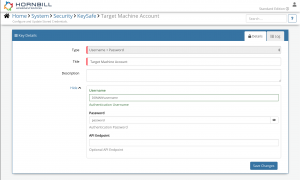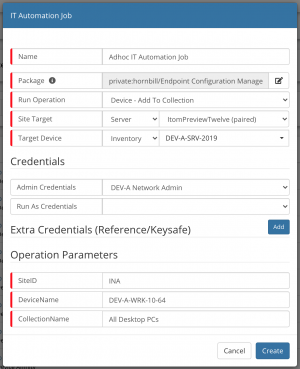Endpoint Configuration Manager
| Home > Administration > IT Operations Management > ITOM Package Library > Endpoint Configuration Manager | Index |
IntroductionThe Endpoint Configuration Manager package for Hornbill's IT Operations Management (ITOM) contains operations to manage Microsoft Endpoint Configuration Manager Devices, Scripts, Packages and Discoveries. |
|
Target Environment Requirements
Script Execution Machine Requirements
- PowerShell v5.0 or above;
- The ConfigurationManager PowerShell module needs to installed on the machine that will be executing the operations;
- If the script execution policy on the machine executing these operations is set to Restricted, then this will need to be updated to something less restrictive. See the PowerShell Documentation for more information.
KeySafe Configuration
When creating SIS jobs for operations contained within this package, they need to be run on the target machine as a user who has the correct privileges on the target.
To configure your Target Machine account authentication in KeySafe:
- In the Admin console, navigate to: System > Security > KeySafe;
- Click on + then select
Username + Password; - Give the KeySafe Key a Title (this is the name/identifier for the target machine account as you will see it when creating an IT Automation Job, or adding an IT Automation node to a Business Process or Runbook);
- Optionally add a description;
- Populate the Username field with the domain/local account username for the account being used on the target machine;
- Populate the Password field with the password for the above account;
- Select Create Key to save.
Once you have created your KeySafe Key, you can then use it when creating IT Automation Jobs from this package. See screenshots to the right for examples.
Package Operations
The Endpoint Configuration Manager package contains the following operations, than can be used to create ITOM Jobs directly, or included in your Business Processes and/or IT Operations Management Rubooks.
Device - Add To Collection
This operation adds a Device to a Collection. See the Add-CMDeviceCollectionDirectMembershipRule cmdlet documentation for more information.
Extra Credentials
None required.
Input Parameters
SiteID(MANDATORY) - The ID of the target Config Manager Site;DeviceName(MANDATORY) - The name of the Device;CollectionName(MANDATORY) - The name of the Collection.
Output Parameters
errors- Any errors returned by the operation;outcome- Outcome of the operation. Can be OK or FAIL;warnings- Any warnings returned by the operation.
Device - Approve
This operation approves a Configuration Manager Device. See the Approve-CMDevice cmdlet documentation for more information.
Extra Credentials
None required.
Input Parameters
SiteID(MANDATORY) - The ID of the target Config Manager Site;DeviceName(MANDATORY) - The name of the Device.
Output Parameters
errors- Any errors returned by the operation;outcome- Outcome of the operation. Can be OK or FAIL;warnings- Any warnings returned by the operation.
Device - Block
This operation blocks a Configuration Manager Device. See the Block-CMDevice cmdlet documentation for more information.
Extra Credentials
None required.
Input Parameters
SiteID(MANDATORY) - The ID of the target Config Manager Site;DeviceName(MANDATORY) - The name of the Device.
Output Parameters
errors- Any errors returned by the operation;outcome- Outcome of the operation. Can be OK or FAIL;warnings- Any warnings returned by the operation.
Device - Get Details
This operation returns information about a Configuration Manager Device. See the Get-CMDevice cmdlet documentation for more information.
Extra Credentials
None required.
Input Parameters
SiteID(MANDATORY) - The ID of the target Config Manager Site;DeviceName(MANDATORY) - The name of the Device.
Output Parameters
errors- Any errors returned by the operation;outcome- Outcome of the operation. Can be OK or FAIL;warnings- Any warnings returned by the operation;adSiteName- The AC Site Name where the Device resides;clientState- The Client State;coManaged- Co-Managed?;deviceOS- The Device OS;domain- The Domain the Device belongs to;epDeploymentState- The EP Deployment State;isAssigned- Is Assigned?;isClient- Is Client?;isDecommissioned- Is Decommissioned?;isDirect- Is Direct?;name- The Device Name;resourceId- The Resource ID;resourceType- The Resource Type.
Device - Remove
This operation removes a Configuration Manager Device. See the Remove-CMDevice cmdlet documentation for more information.
Extra Credentials
None required.
Input Parameters
SiteID(MANDATORY) - The ID of the target Config Manager Site;DeviceName(MANDATORY) - The name of the Device.
Output Parameters
errors- Any errors returned by the operation;outcome- Outcome of the operation. Can be OK or FAIL;warnings- Any warnings returned by the operation.
Device - Remove From Collection
This operation removes a Configuration Manager Device from a Collection. See the Remove-CMDeviceCollectionDirectMembershipRule cmdlet documentation for more information.
Extra Credentials
None required.
Input Parameters
SiteID(MANDATORY) - The ID of the target Config Manager Site;DeviceName(MANDATORY) - The name of the Device;CollectionName(MANDATORY) - The name of the Collection to remove the Device from.
Output Parameters
errors- Any errors returned by the operation;outcome- Outcome of the operation. Can be OK or FAIL;warnings- Any warnings returned by the operation.
Device - Unblock
This operation unblocks a Configuration Manager Device. See the Unblock-CMDevice cmdlet documentation for more information.
Extra Credentials
None required.
Input Parameters
SiteID(MANDATORY) - The ID of the target Config Manager Site;DeviceName(MANDATORY) - The name of the Device.
Output Parameters
errors- Any errors returned by the operation;outcome- Outcome of the operation. Can be OK or FAIL;warnings- Any warnings returned by the operation.
Invoke Discovery - System
This operation invokes a System Discovery in a Configuration Manager Site. See the Invoke-CMSystemDiscovery cmdlet documentation for more information.
Extra Credentials
None required.
Input Parameters
SiteID(MANDATORY) - The ID of the target Config Manager Site.
Output Parameters
errors- Any errors returned by the operation;outcome- Outcome of the operation. Can be OK or FAIL;warnings- Any warnings returned by the operation.
Invoke Discovery - User
This operation invokes a User Discovery in a Configuration Manager Site. See the Invoke-CMUserDiscovery cmdlet documentation for more information.
Extra Credentials
None required.
Input Parameters
SiteID(MANDATORY) - The ID of the target Config Manager Site.
Output Parameters
errors- Any errors returned by the operation;outcome- Outcome of the operation. Can be OK or FAIL;warnings- Any warnings returned by the operation.
Invoke Discovery - User
This operation invokes a User Discovery in a Configuration Manager Site. See the Invoke-CMUserDiscovery cmdlet documentation for more information.
Extra Credentials
None required.
Input Parameters
SiteID(MANDATORY) - The ID of the target Config Manager Site.
Output Parameters
errors- Any errors returned by the operation;outcome- Outcome of the operation. Can be OK or FAIL;warnings- Any warnings returned by the operation.


